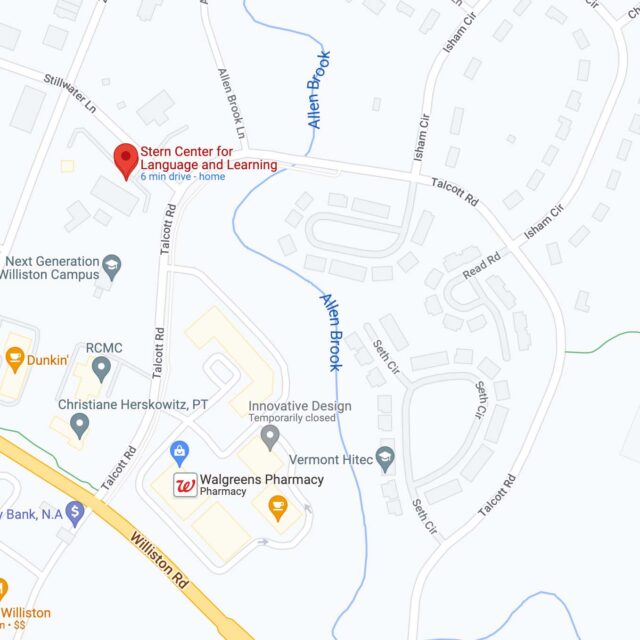
In this video, Michelle Szabo, Program Manager for Instruction at the Stern Center for Language and Learning, discusses executive function skills and what they mean for your child at home and for your student in the classroom.
“Executive function skills are the mental processes that enable us to plan, focus attention, remember instructions, and juggle multiple tasks successfully. Just as an air traffic control system at a busy airport safely manages the arrivals and departures of many aircraft on multiple runways, the brain needs this skill set to filter distractions, prioritize tasks, set and achieve goals, and control impulses. Executive function and self-regulation skills depend on three types of brain function: working memory, mental flexibility, and self-control.”
– Center for the Developing Child at Harvard University
(Beginning of Video Transcript)
Executive function skills are those mental skills that we use every day to get the regular parts of our day done. We use them to help set goals, to plan what we’re going to do and when we’re going to do it, to help prioritize the tasks that we need to do, and then help start them and finish them. Finally, executive function skills help us manage our time and our possessions. Today, were going to focus on our possessions and organization.
We’re going to talk about the backpack situation today. We’ve all seen the backpacks come home from school. Teachers have seen it from their students where they asked for a homework assignment and the backpack is a disaster zone. The child opens it up and it’s the abyss of papers crumpled up at the bottom, cookie crumbs, dirty gym socks, books and binders all over the place; everything askew.
We are going to talk about three easy steps to help your child begin to organize their backpack with the assistance of a parent or a teacher and then learn how to become independent in keeping their backpack organized over time.
When they know how to organize their backpack and how much easier it makes life, the more engaged they will be in the process and the more likely they will be to embrace, maybe not lovingly, but embrace keeping their backpack a little bit neater. It enables our children and our students to access the work that they’re doing at school and bring it home and share it with parents in a more organized fashion and it helps them get started on homework more easily and more quickly at home and remember to turn it in the next day at school.
Is important to note that parents need to be part of this process at home just like teachers need to be part of this process with their students at school. It’s really a team effort for kids who struggle with organization issues that we all assist the students. That is one of the things we do at the Stern Center is work with our students one-to-one to help them set up these processes and then touch base with them every week to make sure it’s working for them. We need to find the strategies that are just right for the student.
The “Goldilocks Backpack”
Speaking of just right, we’re going to talk about the “Goldilocks backpack”. The “Goldilocks backpack” is essential in helping our students get started and stay going in the right direction.
The “Goldilocks backpack” as I call it, is one that is just the right size for the student. You need to consider:
- The student’s physical size
- What grade they’re in
- How many school materials they have
It can’t be a tiny little backpack or a huge backpack that weighs more than they do when it’s filled. It needs to be the right size for their frame because they’re going to be carrying it around with them an awful lot.
You need to make sure that there is the right amount of pockets or sections for the student. Too many pockets means too many places for kids to put things and forget where they’ve placed them.
One thing that some students have found to be successful is wheels. Backpacks on wheels. Some schools allow them and some schools don’t allow them so make sure before you buy a backpack on wheels that you check with the school to make sure it is within their regulations.
The final thing to consider is a space in the backpack for technology. A lot of our kids have cell phones, tablets, chrome books, or other laptops, so when we buy a backpack make sure that there is a secure place to keep our technology safe.
Organizing the Backpack
The second step in our process of organizing our backpack is working with our children to empty the backpack, sort the materials, and then map it out. If you’re doing this with your students at school you’ll want to have a nice big open space to have the student take everything out of their backpack and start putting everything into three piles:
- One pile is going to be for school supplies, the things that the child needs every single day: the books that they’re reading, the textbooks, the binders.
- The next pile is going to be loose papers, loose tests and quizzes; materials that they may need but haven’t found a home yet.
- The last is one pile for things that the child is going to take from home to school and then back home again. Everything else, if it doesn’t fit in one of those three piles, can be filed away at home in the storage bin in the attic for a memory later or can be thrown away, totally up to you.
Now, once you’ve sorted into three piles, you need to sort those piles:
- Match the notebooks to the textbook or the literature book. If the child is in English, you may want to have a specific color binder or folder or notebook just for that English class. The same can be said for history and science and so on.
- You want to collect all of the writing implements: crayons and colored pencils and put them all in one place so that the student knows where they belong.
- Then you want to have a section for gym clothes. Most kids have PE up through high school. They need to bring a change of clothes and they don’t always have a locker so you want to have a designated section just for their PE change of clothes.
The final step in this process is mapping the backpack. It is essential that the child or the student, depending on if you’re at home or at school, works with you to decide what is going to go where in their backpack. Find a place for the technology first, usually there is a designated spot in a book bag or a backpack for technology. After that you want to have a section for your gym clothes and then a section for your books and materials for school. Many of us have a three-ring binder that we use. I want to have the three-ring binder in the back so that it really helps organize and establish the framework for the rest of the backpack.
The “Keep it Ups”
Finally, the last step in our organization of backpacks is what we call “a place for everything and everything in its place.” This is the “keep it up’s” part of the strategy. Some of our students are going to do really well embracing a clean backpack and keep it up for a couple of weeks but if you don’t check in regularly you may find that the crumpled up papers go back to the bottom of the backpack with cookie crumbs and snack wrappers and dirty gym socks. You’re going to want to help them maintain this nice clean backpack through the rest of the school year. In order to do that you may need to check in with them every week. Maybe on a Friday after the last school day or maybe on Sundays they are getting ready for the next week and working on homework for the upcoming assignments that are due. You are going to want to have a Home/school folder as well. This will be a place where parents can communicate more effectively with the classroom teacher: send permission slips home or notes to the teacher. Maybe it is a place where kids put their homework every day so that they know that they have to take it out at school and the student gives their work to the teacher and puts work to be done at home back into the folder and back into where it belongs in the backpack.
At the end of the week or every two weeks students are going to need to make sure that all of those loose papers find the right place to go back in the backpack. Do they get filed at home, do they need them to study for a quiz or a test, do they need to be put into a binder or a folder, or returned to the classroom teacher?
You want to give students in your classroom five minutes at the end of the day, if possible, and I know our days are very busy but, a few minutes at the end of the day organizing the backpack and making sure that they put their things where they belong will help us all out in the long run.
One thing to consider for parents is maybe a reward. Some children really respond well to having a reward for meeting a goal and so working with them on a clean backpack, and if they are successful and independent in keeping it organized and cleaned up, maybe they get a book or they read aloud with the family, or a treat. Again, that is up to each individual family.
(End of Video Transcript)
If you are interested in learning more about executive function and the services we offer please review our Customized Instruction page.
[instructor id=”2759″]
